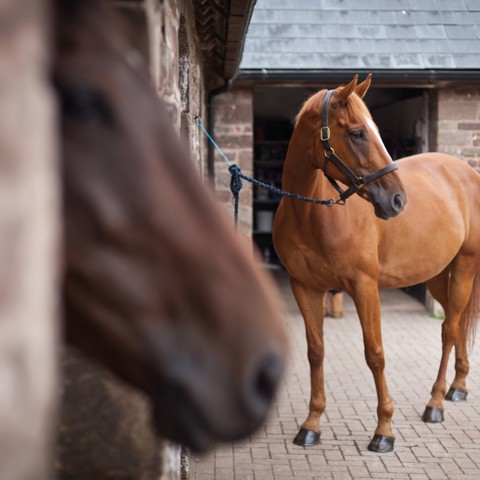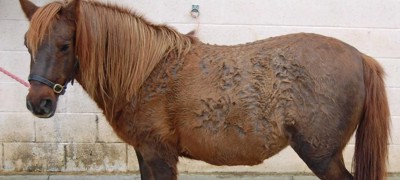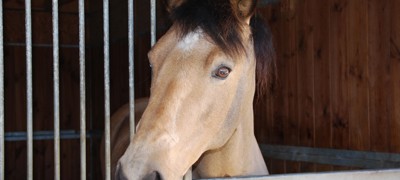Laminitis can affect any equine, at any time of the year and not just in spring – there is no ‘safe season’.
Advice specific to donkeys is available from The Donkey Sanctuary.

What is laminitis?
Laminitis affects tissue called sensitive laminae which are found in the horse’s hoof. The sensitive laminae act like velcro to form a strong bond to support the pedal bone within the hoof. Laminitis causes the sensitive laminae to stretch, weaken and become damaged which can cause the pedal bone to move within the hoof (think of a zip being un-done).
In extreme cases, the pedal bone can rotate and/or drop through the sole of the hoof which is very painful. In cases like this, euthanasia is likely to be the only treatment option to end the horse’s suffering.
What causes laminitis in horses?
Any horse or pony can be affected by laminitis, but some can be more susceptible than others. Excess weight gain can more than double the risk of laminitis developing1. Fat scoring your horse will help monitor their weight.
It is important to investigate the cause of laminitis to help you manage the condition and prevent future episodes. The causes of laminitis fall into three broad categories:
Hormonal Laminitis
chevron-down
chevron-up
Both Equine Cushing’s Disease and Equine Metabolic Syndrome (EMS) are hormonal conditions associated with laminitis. Up to 90% of laminitis cases are linked to insulin dysregulation and obesity2.
These conditions can lead to high levels of insulin in the bloodstream which is known to cause laminitis. Therefore, recognising and managing these conditions before laminitis develops is the best defence.
If your horse does have underlying Cushing’s Disease or EMS, the use of corticosteroids could increase the likelihood of laminitis developing (there is no conclusive evidence of this in healthy horses)3. Your vet will be able to discuss any potential risks and advise on hormonal testing for your horse.
Inflammatory Laminitis
chevron-down
chevron-up
If concentrates form part of your horse’s diet, ensure they are not fed in excess and are ideally fed over at least two meals a day to aid digestion.
Eating a large amount of concentrates in one go can cause an overload in the digestive system with undigested sugar and starch pushed through to the hindgut, where it starts to rapidly break down. This process can damage the gut causing toxins to enter the bloodstream. It is thought that the toxins may affect the blood supply reaching the laminae and increase the risk of laminitis.
Speak to your vet or a nutritionist for further information on the specific dietary needs for your horse.
Other potential causes of inflammatory laminitis include some colic cases where the gut has been severely damaged, severe inflammation of the lungs, and retained afterbirth (placenta) in mares after foaling.
Abnormal weight bearing laminitis
chevron-down
chevron-up
Abnormal weight bearing laminitis can be caused when a horse has a condition or injury where it is unable to put weight on a leg so uses the opposite leg to support their weight. Laminitis can occur in the hoof taking the extra weight.
Other causes: Mechanical
chevron-down
chevron-up
Mechanical issues can contribute to the development of laminitis and may include; too much length of toe on the hoof, improper shoeing or foot trimming, fast or prolonged work on hard ground, fracture, joint infection, or soft tissue damage in the opposite limb4.
Working with your vet to find out the cause of your horse’s laminitis is important as this can help with treatment and ongoing management needs.
 play-circle
play-circle
Watch
Recognising Laminitis and Reducing the Risk
Subtle Signs

Laminitic Stance
The photo below shows what’s known as the laminitic stance, where the horse rocks back on their hind legs to take the weight off their front feet. This has been found to occur in less than half of diagnosed laminitis cases5.

Photo credit: The Royal Veterinary College
Three Stages of Laminitis
1) Subclinical laminitis happens when small changes within the hoof are beginning to take place, but the horse is yet to show, or is only showing very subtle signs.
2) Acute laminitis is when the first signs of pain and lameness show. Signs can be subtle so they may be mistaken for other issues. Knowing what is normal for your horse is important as any subtle signs of laminitis, can be spotted sooner.
3) Chronic laminitis causes painful changes to the structures within the hoof (visible on X-ray). Horses with chronic laminitis can also show visible changes on the outside of the hoof although these are not always accompanied by pain (as shown below). Due to the physical changes on the inside and outside of the hoof, these horses are at high risk of future laminitis episodes.
Visible signs of laminitis in the hooves
Changes to the shape and angle of the hoof
chevron-down
chevron-up

Photo Credit: Kieran O'Brien/Penbode Equine Vets, part of VetPartners family.
Rings on the outer hoof wall that are wider at the heel and narrower at the toe
chevron-down
chevron-up

Kieran O'Brien/Penbode Equine Vets, part of VetPartners family.
A groove/indent just above the coronet band, highlighted on the image by the blue line
chevron-down
chevron-up

Photo Credit: Kieran O'Brien/Penbode Equine Vets, part of VetPartners family.
Bruising on the sole of the foot, usually just in front of the frog
chevron-down
chevron-up

Photo Credit: Kieran O'Brien/Penbode Equine Vets, part of VetPartners family.
What should I do if I suspect my horse has laminitis?
Call your vet immediately for advice - laminitis should always be considered an emergency.
Don’t force your horse to walk if they are resisting. Your horse is likely to be in a lot of pain and there is a risk of causing more damage to the laminae. If your horse is able to walk, carefully move them to a nearby stable or shelter. If it is not possible to move your horse, try to make them comfortable where they are and restrict their movement and access to grass if necessary. If shavings are available set up a deep bed as this will provide support especially under the hoof, frog and pedal bone and cushioning to support the horse’s weight when standing. Wait for your vet to arrive to offer further advice.
Laminitis treatment
Acute
chevron-down
chevron-up
Your vet is likely to prescribe painkillers and advise a period of box rest with a deep bed of shavings. Once the pain has initially been managed, your horse’s hooves may have to be trimmed by your farrier to relieve any pressure and sole or frog supports fitted.
Chronic
chevron-down
chevron-up
Your vet is likely to work closely with your farrier, as remedial farriery is a big part of the management of chronic laminitis. The aim is to:
- Help relieve pressure
- Stabilise and maintain correct foot balance
- Rehabilitate the foot.
Options for pain management and alternative treatment options may be suggested by your vet. In serious cases of laminitis (acute or chronic) where the chance of recovery is poor, euthanasia is often recommended to prevent further suffering.
Further reading
References
chevron-down
chevron-up
- Pollard, D., et al (2018) Incidence and clinical signs of owner-reported equine laminitis in a cohort of horses and ponies in Great Britain. Equine Veterinary Journal. 51(5), pp. 587-594
- Karikoski NP, et al (2011). The prevalence of endocrinopathic laminitis among horses presented for laminitis at a first-opinion/referral equine hospital Domestic Animal Endocrinology. 41(3), p. 111-7.
- Mcgowan, C, M. et al (2016) No Evidence That Therapeutic Systemic Corticosteroid Administration is Associated With Laminitis in Adult Horses Without Underlying Endocrine or Severe Systemic Disease. Veterinary evidence. 1(1).
- Evans. J. (2019) Laminitis – A year round problem.
-
Wylie CE, et al (2016). Decision-tree analysis of clinical data to aid diagnostic reasoning for equine laminitis: a cross-sectional study. Vet Record. 178(17): 420.





